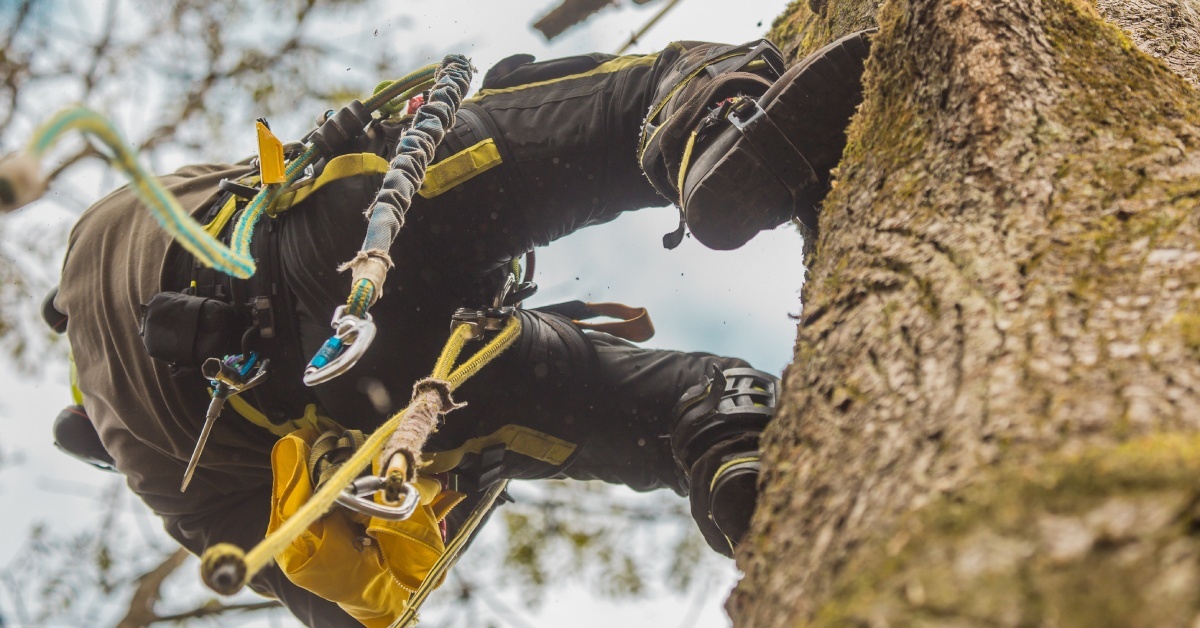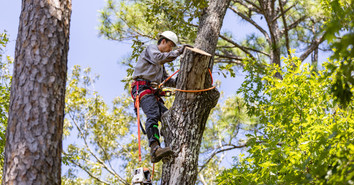Professional arborists and tree care specialists understand that their safety equipment represents the critical difference between a successful day's work and a potentially fatal accident. The climbing harness serves as the foundation of every tree care operation, providing the essential connection between climber and tree while supporting hours of demanding physical work.
Choosing the best climbing harness setup for tree care requires careful consideration of multiple factors, including comfort, durability, and more. The wrong choice can lead to discomfort, reduced productivity, or worse, equipment failure during critical moments. Follow our helpful guide to learn how to find the perfect harness for you and use it successfully on your next job.
Understanding the Basics of Climbing Harnesses for Tree Care
Tree care harnesses differ significantly from rock climbing or rescue harnesses due to the unique demands of arborist work. These specialized harnesses must accommodate extended periods of suspension, frequent repositioning, and the attachment of numerous tools and equipment pieces. The design emphasizes comfort during prolonged use while maintaining the strength and reliability required for professional applications.
The primary components include a waist belt, leg loops, and various attachment points strategically positioned for optimal weight distribution and accessibility. The leg loops are designed to accommodate the frequent leg movement required when navigating through tree canopies.
Safety certifications represent another crucial aspect of harness selection.
For example, you can find a tree saddle harness at Monarch Rope that is specifically designed in compliance with CE, ASTM, and ANSI standards. Following these standards means these harnesses go through substantial testing for strength, durability, and safety performance under realistic working conditions.
Key Features to Consider When Selecting a Harness
Comfort during extended wear should top your priority list when evaluating potential harness options. Padding thickness and placement directly impact how the harness feels during long work days, with high-quality foam providing superior comfort without excessive bulk. The waist belt should distribute weight evenly across your lower back and hips, while leg loops should support your thighs without restricting circulation or movement.
Adjustability allows the harness to accommodate different clothing layers throughout varying weather conditions and ensures a proper fit as your body changes over time. Quality harnesses feature multiple adjustment points, including waist circumference and leg loop size positioning.

Attachment Points & Material Construction
Attachment points determine how effectively you can organize and access your tools while working aloft. Multiple gear loops of varying sizes accommodate different tool types, from small hand tools to larger equipment like chainsaws. D-rings provide secure attachment points for lanyards and climbing lines, with their positioning affecting both comfort and functionality during various work positions.
Material construction directly impacts both durability and comfort characteristics. High-quality nylon webbing remains strong under working conditions while maintaining flexibility over time.
Proper Fitting and Adjustment for Maximum Safety
Achieving the correct fit requires attention to multiple measurement points and adjustment mechanisms. The waist belt should sit comfortably above your hip bones without restricting breathing or movement.
Leg loop adjustment affects both comfort and safety performance. Properly fitted leg loops should support your thighs without creating pressure points or restricting blood circulation. The loops should remain in position during normal movement without sliding down or bunching up.
Verifying Performance Quality
Test the fit by sitting in the harness before committing to extended work sessions. Load distribution testing helps identify potential problems before they become safety issues. Suspend yourself in the harness using your normal climbing setup and pay attention to pressure points, binding, or discomfort.
Adjust positioning and tightness as needed to achieve comfortable weight distribution across all contact points.
Regular fit verification ensures your harness continues to provide optimal performance as conditions change. Seasonal clothing variations, physical changes, or equipment modifications may require harness adjustments to maintain proper fit and function. Perform periodic fitting checks to address any changes before they compromise safety or comfort.
Essential Gear and Accessories for Your Harness Setup
If you want to choose the best climbing harness setup for tree care, you must consider the specific gear you will use.
Tool organization accessories transform a basic harness into an efficient mobile workstation.
Dedicated holsters for specific tools keep frequently used items within easy reach while preventing accidental drops. Chainsaw scabbards provide secure storage for powered equipment while protecting both the operator and the saw chain during repositioning moves.
Gear loops serve multiple functions beyond simple tool attachment, providing anchor points for auxiliary equipment. The number and positioning of gear loops should align with your typical tool complement to avoid overcrowding while ensuring everything remains accessible.

Connecting Hardware & Line Management Systems
Connecting hardware, including carabiners, D-rings, and snap hooks, must match the strength ratings of your harness and other safety equipment. Steel carabiners offer maximum strength and durability for primary attachment points, while aluminum options provide weight savings for secondary attachments.
Rope and line management accessories help organize climbing lines and work positioning systems to prevent tangles and improve efficiency. Rope bridges distribute loading forces between multiple attachment points while providing a stable platform for connecting various devices. Line keepers prevent excess rope from interfering with work activities or creating entanglement hazards.
Maintenance Tips to Extend the Life of Your Harness
Cleaning procedures should address both functional and aesthetic concerns while preserving the integrity of harness materials. Regular cleaning removes debris, sap, and contaminants that can degrade webbing and hardware over time. Use mild soap and water for routine cleaning, avoiding harsh chemicals that might weaken synthetic materials or cause premature deterioration.
Inspection routines help identify potential problems before they compromise safety. Examine all webbing for cuts, abrasion, or unusual wear patterns that might indicate structural weakness. Check stitching at attachment points and stress areas for loose threads or separation. Hardware components should move freely without binding or excessive wear.
Find Secure Storage Solutions
Storage considerations protect your harness investment during periods of non-use. Avoid exposing the harness to extreme temperatures, direct sunlight, or chemical contaminants during storage.
Hang the harness in a clean, dry location where air can circulate freely around all components.
Replacement criteria help determine when harness retirement becomes necessary for safety reasons. Any visible damage to load-bearing components, significant wear patterns, or involvement in a serious fall should trigger immediate retirement regardless of age or appearance.
Investing in Your Safety and Success
The climbing harness represents far more than just another piece of equipment in your tree care arsenal. Your choice directly impacts daily comfort, work efficiency, and most importantly, personal safety during every climb. Taking the time to thoroughly evaluate your specific needs, work patterns, and physical requirements will guide you toward the harness setup that serves you best throughout your professional career.
Professional tree care demands equipment that performs reliably under challenging conditions while providing the comfort and functionality needed for efficient work. The right harness setup becomes an extension of your professional capabilities, enabling you to tackle complex jobs with confidence and security.
Remember that the best harness is the one that fits your specific needs, work style, and physical requirements rather than simply the most expensive or feature-laden option available.

